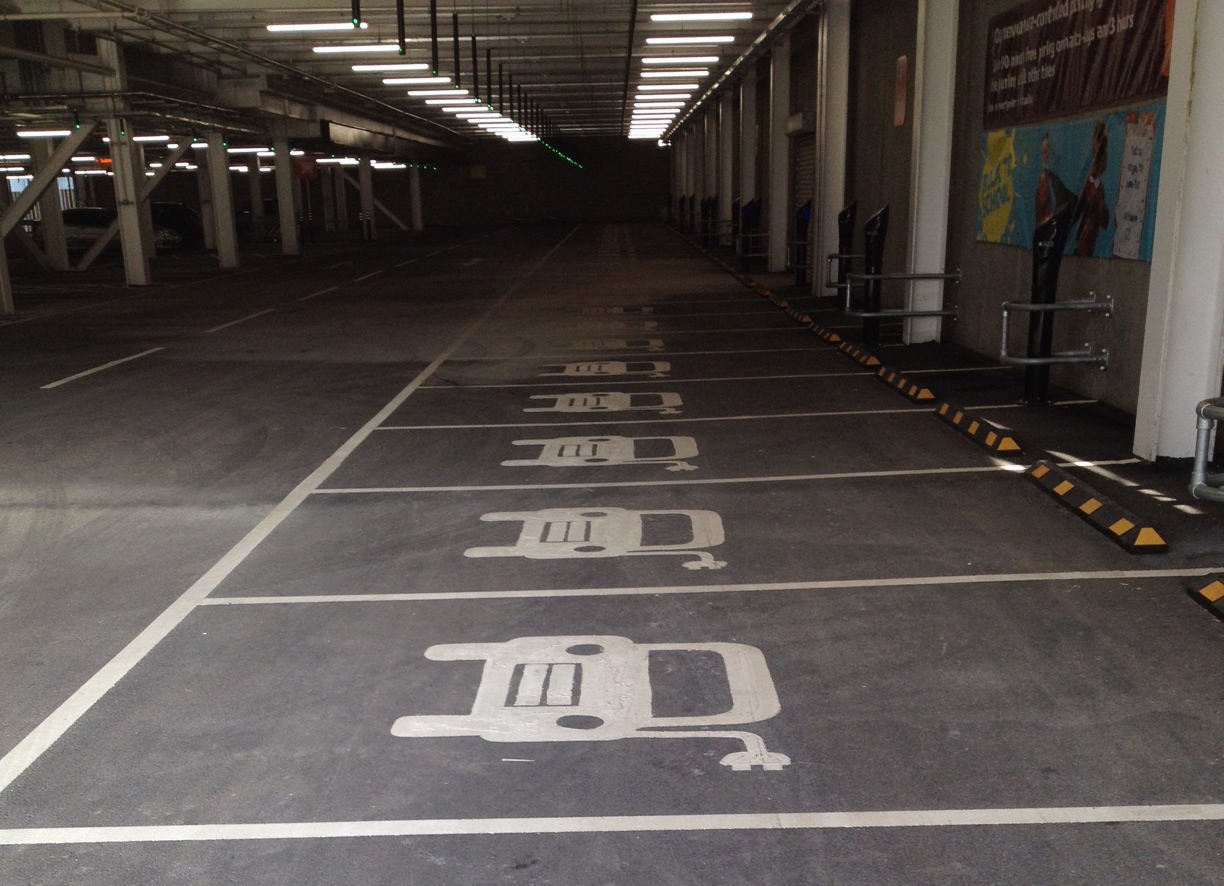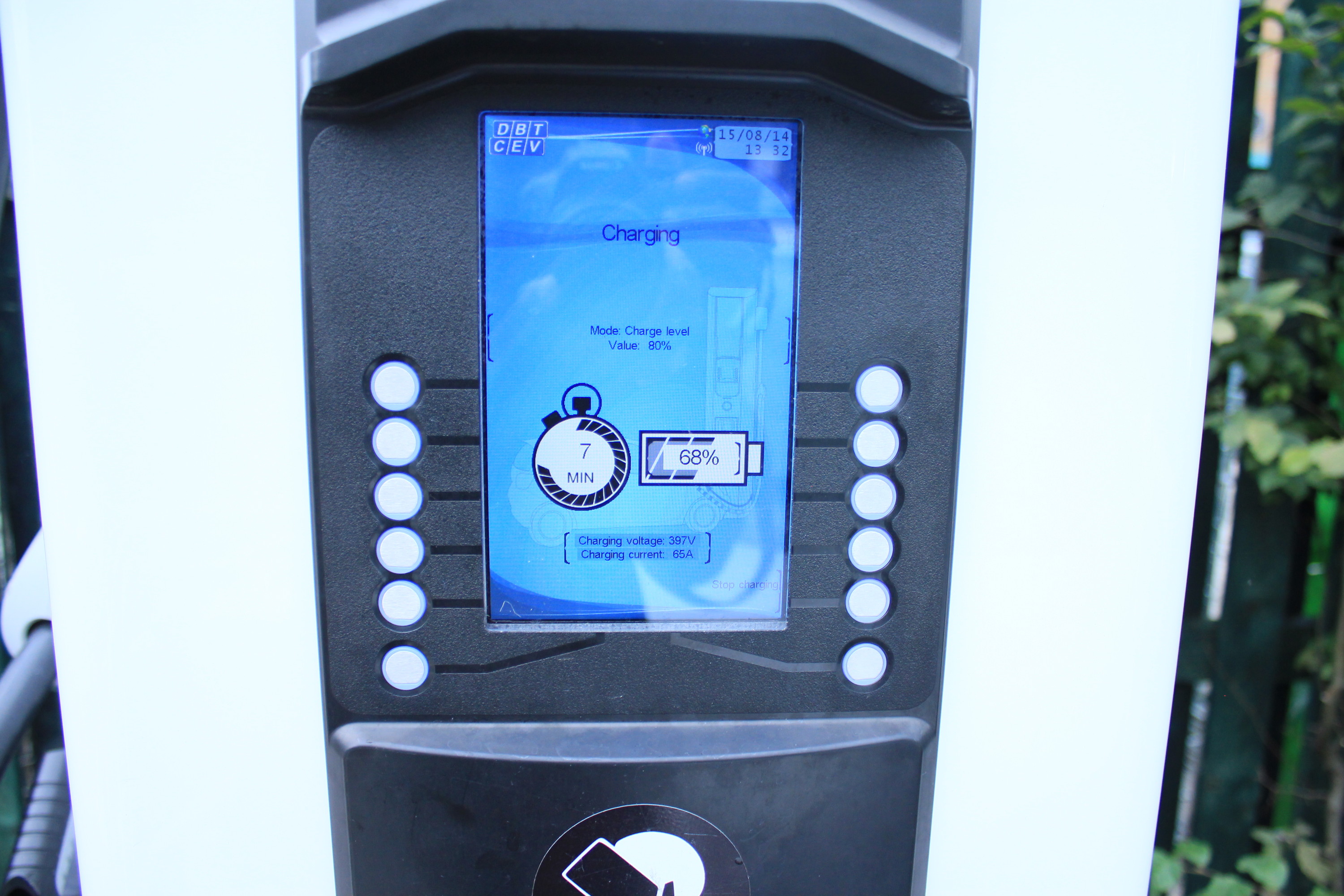For the benefit of people who don’t know a lot about Electric Vehicles (EVs), it’s fair to say that adoption in the UK so far has not been widespread. A survey carried out in June 2014 by the Department of Transport found only 0.3 per cent were EV owners (sample of 962 people aged 16 and over across Great Britain). The two main concerns, or barriers to adoption, were recharging and the potential range of a charge.
That said, there has been a big push from the government to increase EV adoption – benefits include a 5k subsidy, free road tax, congestion charge exemption and, at present, the vast majority of public charge points are free to use.
I was keen to learn more about EV usage, and cycled to many charge points around central London, staking them out and waiting for people to come and charge so I could talk to them. I mostly found empty stations. I went further out, to find shopping centre car parks with long rows of charge stations, waiting patiently, as tumbleweed passed by ...

What we found
I quickly gathered that broken charge points are a big problem in London – I experienced this first-hand and confirmed it with numerous EV owners. One woman I interviewed had once been to 5 broken charger points in a row. This can be a hugely frustrating experience.
Bad data is at the heart of this problem – many of these frustrations could be avoided if people knew not to travel to certain charge points when they were out of order.
Journey-planning pains are also an issue for the less experienced EV drivers, although there will always be an in-car interactive centre console which, in theory, has the ability to get you to charging stations when needed, some car manufacturers align with certain networks and won’t display the other network’s charge points on their maps. The vast majority of people I spoke to did not rely on the in-car centre console, instead resorting to an app on their phones.
The digital products being offered in this space at present are poor, with low quality and unreliable data a big part of it. To compound this, they often have huge usability issues. Zap Map, which is probably one of the most popular products, is absolutely awful on mobile – the very context where it needs to be strongest.
All these factors manifest on a human level, distorting public perception as it fans the flames of “range anxiety” and other negative and generally misconceived notions.
A lack of faith from their customers in the charge networks is another side effect, with the exception of Ecotricity, who enjoy more loyalty for providing a far more reliable service, offering pure green energy and commitment to a decent level of functionality and service.
EV owners understand that a time will come when public charge points will cease to be free (it's already happening), but they are not prepared to pay for a poor service as was demonstrated when Polar (owned by Chargemaster) launched their Pay per Charge app and hardware, and received harsh criticism from the EV community.
New thinking
What if owning an EV allowed the same spontaneous behavior as normal vehicles, or finding somewhere to charge at any point in the journey wasn’t an issue? Imagine a system that did the heavy lifting for you, drawing in relevant data, creating an end-to-end experience that adapted to the context of your journey.
This product/service could help drive adoption in the UK by removing the journey-related anxieties which exist today, simplifying the experience and building faith in both EVs and their charge networks.
Full tank?
Strangely enough, in the UK we usually measure fuel performance in imperial units (mpg) but buy fuel through metric units (litres). With this in mind how will people conceptualize the purchase of energy as a fuel for their vehicle?
People are used to paying electricity bills, but does everyone understand what a kWh is, and how many their car needs to drive 50 miles?
We need to drive widespread adoption in this country and the more approachable the system is, the more likely it will happen. As mobile phone usage continues to affect our lives perhaps battery %, as a concept, will trump everything else.

Pay for what?
The existing payment model in the UK is for time spent charging your vehicle, not the amount of energy your battery receives, which is completely arbitrary. Opinion is quite mixed within the EV community as to what the most logical or inclusive unit for payment is, some even go so far as to suggest a new metric all together, the E-litre which could simplify the complexity of the relationship between kWh, money, distance and petrol.
My research indicated that the majority of EV owners thought that a straight price per kWh seems the most logical. From a design perspective, giving the user the ability to customize the information presented to them at point of purchase seems appropriate.
Correct etiquette
Charging etiquette is very important in the EV community and smart notifications could go a long way in promoting fair usage of charge points and preventing what is known as ‘charge rage’ (a state of rage induced by petrol vehicles parking in charge bays or other EV owners taking up charge bays when their car is full).
The suggestion of an anonymous p2p messaging service has cropped up in a few places on our travels. Essentially a line of communication from someone waiting for a charge station to the owner of the vehicle in it. The notifications or “Bumps” could be pre-defined (“How long are you going to be?”) as the scope of communication should be limited.
The end of the road
What we refer to as the last mile is also a big consideration, it’s not necessarily just about getting you to a destination but also planning for the return journey. Perhaps you need a destination charge, you are attending a meeting that will last several hours, you shouldn’t block a fast charger, instead the system will guide you to a slow charge point and offer suitable options for the last leg.
Concept Video
Embedded content: https://www.youtube.com/watch?v=WFCDbOY-ACA
Last thoughts
It should be noted that, for day-to-day travel, some of this functionality may not be necessary, a lot of EV owners in London for instance recharge their cars in their own driveways, limiting the need to use public chargers.
This is not always the case though, as proven by Sergio, a Spanish Doctor I met at a charging point. We got on well and I spent the afternoon driving around with him looking for a working charge station in north London. It was his day off and he had to make sure there was a full charge in the battery for his wife who was not a “true believer” in EVs as he was.
This is an interesting space to watch – battery range is increasing, Tesla are set to bring out their more “affordable” Model 3 in 2017 and Ecotricity has put a robust network throughout the main roads of the UK. Having driven a few EVs at this point I definitely feel won over by them. I don’t need a car, living as I do in central London, but if I did I would probably get an EV.
In the UK, right now, you charge your vehicle at any Ecotricity charge point and know that what you get is completely free and 100% green energy. I felt excited by this when I drove EVs, and it made me want take off on a road trip somewhere.
What if we could make these feelings commonplace, by providing an intelligent, dynamic platform working across all the charge networks? Through good design we can remove existing barriers to adoption and drive behavioural change in this area.
Saving money may be the most important factor when people choose to buy an EV, according to a recent survey (SpeakEV), but driving for the sheer pleasure comes in second.
Fossil fuels are a finite resource and, despite recent price falls, driving for fun is rightly becoming a less realistic pastime. Might EVs, however, fill this potential transportational void?